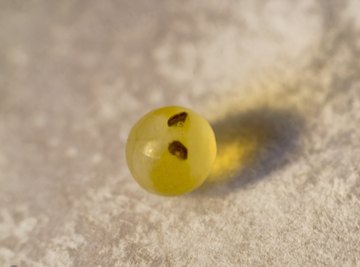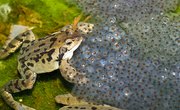
Frogs and a number of other animals have an unusual step in their reproductive cycle: a female's eggs are fertilized by the male's sperm externally, that is, in the environment rather than in the animal's body. External fertilization may seem a mite impersonal, but it carries with it several advantages as well as risks. It's behaviorally simple but in a variable environment, the success rate of fertilization is not very high.
Number of Gametes
Species that use internal reproduction produce relatively few gametes. Because the male directly deposits sperm into the female's body, fewer gametes are needed. External fertilization requires the male and female animals to produce larger numbers of gametes. Males must produce a large number of sperm to ensure that they travel throughout the body of water to meet an egg. Females also must deposit dozens or hundreds of eggs to ensure reproductive success. Producing a large quantity of gametes requires extra energy, which can be disadvantageous to an animal. However, the large number of gametes may result in a large generation of offspring, improving an organism's chance of passing on its genes.
Environment
External fertilization strategies require a body of water to be successful. Sperm have small tails that propel them through water; they would die on land. While depositing gametes in water does not pose a problem for fish, aquatic invertebrates and other animals that live in the water, it can be a disadvantage for other species. Amphibians and creatures that dwell on land must return to water to deposit their gametes.
Success of Fertilization
The close proximity of egg and sperm in internal fertilization increases the likelihood of a successful reproductive cycle. In external reproduction, animals disperse their gametes through a body of water. This dispersal reduces the likelihood that a sperm will find an egg. Many sperm and eggs die before achieving fertilization. The low success rate of external fertilization puts animals at a reproductive disadvantage compared to internal fertilization.
Animal Behavior
External fertilization strategies are behaviorally simpler than internal fertilization. A male and female may deposit their gametes at a slightly different time or place without jeopardizing their reproductive success. In contrast, animals using an internal fertilization strategy rely on hormones, mating rituals and behavioral factors to ensure that the male and female have sexual intercourse. The external fertilization strategy does not require these adaptations, making it a simpler reproductive strategy.
References
About the Author
Lawrence Adams' work has appeared in the "Marquette Literary Review" and "Broadview Press." He has a Bachelor of Arts from Marquette University in writing-intensity English and classical studies, with a minor in biology, and a Master of Arts in creative writing from the University of Illinois at Chicago.
